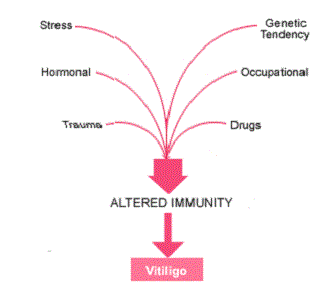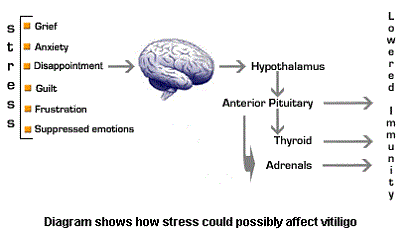- Our Location
- #604 1087 2nd Ave NW CALGARY ALBERTA,
POSTAL CODE T2N 5B2 Canada
- working hours
- Mon - Fri : 9:00 Am - 5:00 Pm
- Our Location
- #604 1087 2ND AVE NW CALGARY ALBERTA,
POSTAL CODE T2N 5B2 CANADA
- working hours
- Mon - Fri : 9:00 Am - 5:00 Pm
What is Vitiligo?
Vitiligo is a disease of skin pigments called melanin. It is a disease where there is a loss of skin pigment or color, which could be due to various reasons. Vitiligo affects about 2% of world population and closes to 8% of Indian and Mexican population. Vitiligo is not a serious disease, medically speaking. It has more social significance than medical importance, as it does not cause any major harm to the body. Cosmetically and personally, it can affect lives of the suffers especially in those societies, where color of skin is given importance; specially among brown and dark skin people.
In simple words, vitiligo is caused by one or two of the following processes:
01 Melanin cell destruction, leading to loss of color on skin, leading to white patches of vitiligo.
02 Defective process of melanin formation, hence, no skin color formation
The exact cause for above processes remain unknown. There are some theories which are considered responsible for the above processes in vitiligo. The probable causes of vitiligo explained elsewhere on this site. In brief, genetic and immunological factors in the background are considered responsible for vitiligo.
 Due to destruction of the melanin (pigment) cells due to lesser known processes (largely what is called as an auto-immune disorder) the normal skin starts loosing pigments from various parts of the skin, in a varying speed and extent. Our clinical experience based on the treatment of over 9365 cases (as on Feb 2017), suggests that there is a strong genetic factor in the background of most cases, especially those who have extensive vitiligo or those who have vitiligo affecting the finger-tips, toes, lips or the genitals. The indication of strong genetic factor is observed in the form of family history of one or more of the auto-immune diseases such as vitiligo, alopecia areata, diabetes, under active thyroid, cancer, rheumatoid arthritis or allergies.
Due to destruction of the melanin (pigment) cells due to lesser known processes (largely what is called as an auto-immune disorder) the normal skin starts loosing pigments from various parts of the skin, in a varying speed and extent. Our clinical experience based on the treatment of over 9365 cases (as on Feb 2017), suggests that there is a strong genetic factor in the background of most cases, especially those who have extensive vitiligo or those who have vitiligo affecting the finger-tips, toes, lips or the genitals. The indication of strong genetic factor is observed in the form of family history of one or more of the auto-immune diseases such as vitiligo, alopecia areata, diabetes, under active thyroid, cancer, rheumatoid arthritis or allergies.
The vitiligo sufferers are observed all over the world, including the white skin population. However, epidemiologically most cases are recorded in India (8.8 %) and Mexico. Estimated 1-2% of the Americans have vitiligo as per the survey made by the American Academy of Dermatology. Males and females are affected equally, including children of all age groups. It may begin at any age. Childhood vitiligo is not uncommon. We have registered cases as young as three months old, to late onset vitiligo at the age of 80 years.
Causes of Vitiligo


Vitiligo is a disease of which the exact cause is not fully understood. However, there is increasing understanding about the processes involved in the development of Vitiligo. In most cases there are multiple causes responsible for vitiligo. However, there are theories suggesting
a. Autoimmune links: The cells fighting among themselves leading to destruction of the melanin, is one of the reasons. There are other immunological factors as well. One of the studies has suggested role of some neuropeptide (NYP) which may damage melanin. Such neuropeptide may be released in response to skin injury or emotional stress; again suggesting a combination of causative factors.
b. Hormonal connections: Affection of certain hormones such as Thyroid hormones or Melanocyte Stimulating hormone may be responsible for vitiligo. Also, simultaneous occurrence of vitiligo and other hormonal disorder suggest underlying genetic factor.
c. Genetic tendencies
d. Neural theory
e. Autocytotoxic theory
We have made an important observation through a study that most patients with vitiligo have one of the family members (father, mother, grand parents on either side, uncle, aunt or siblings) suffering from one or more of the following diseases:
a. Vitiligo
b. Hypothyroid or under active thyroid
c. Diabetes
d. Alopecia Areata (patchy hair loss)
d. Cancer
e. Other auto-immune diseases (such as psoriasis, rheumatoid arthritis, lichen planus, etc.)
f. vitiligo after injury
A study at our center also shows that the patients who have either extensive vitiligo or those developing vitiligo spots on both sides of body (bilateral symmetrical) have a strong genetic element. In other words, it is difficult for any patient to have extensive vitiligo without genetic links.

Vitiligo and Hypothyroidism (Under active thyroid):
Research suggests that Vitiligo and Hypothyroidism (Under active thyroid) often are predisposed by the same gene (NALP1 gene). All patients of Vitiligo are suggested to get Thyroid profile done every six months. Thyroid profile entails blood sample study for T3, T4 and TSH (Thyroid stimulating hormone) hormones at a small cost.
Symptoms of Vitiligo
The typical symptom of Vitiligo is a milky white de-pigmented spot or spots. It may vary from a single white spot to multiple spots. The shape too is a variable; round or irregular in shape. In some cases generalized de-pigmentation observed all over the body. It has a tendency to start as a single spot and gradually grow in size and number. It may present with a single or several spots on limbs or abdomen or back and then spreading to other parts of the body. In some of the vitiligo patches the hair may turn grey suggesting of loss of melanin pigment at the roots.
In some cases showing affection of the muco-cutaneous junctions such as finger-tips, corners of the mouth, genital, around eyes. The spread of the disorder is usually slow and progressive. Symmetrical appearance on both the sides of the body (say, on the legs, hands, etc.) is common. In rare cases one finds vitiligo spreading all over the body. It is a common concern among the patients if the disease would spread to entire body; which happens very rarely.



Scattered (solitary) Finger tips: Vitiligo on Hands


Vitiligo with grey hair Feet: Vitiligo on Ankles
How Vitiligo Spreads?
The spread of vitiligo is governed by various factors such as 1. Genetic activity 2. Hormonal factors 3. Continued Stress factors 4. Exposure to chemicals, etc. Many patients may start with just a single spot and may not get more spots for many years or for throughout life time. Some patients may show rapid spread, as fast as from one spot to hundreds, in a few months time. It is not possible to predict the pace of spread. Also, some patients may show intermittent spread. It may be noted form experience that those who pace certain body areas affected such a finger tips, are at higher risk of having an aggressive spread; it is not a rule though. Some patients may present with grey hair, suggesting loss of pigment in the hair.
Associated Systemic Disorders:
There are several systemic diseases symptoms (affecting the entire body system), which are at times associated with Vitiligo: 1. Under active thyroid 2. Diabetes 3. Alopecia Areata (patchy hair loss) 4.SLE (Systemic Lupus Erythematosus) 5. Pernicious Anemia 6. Addison's Disease 7. Collagen Diseases 8. Grave's Disease
It may be noted that the sufferers of Vitiligo need not be unduly scared of the above disease conditions, as they should not be regarded as the complications of Vitiligo in every case. The most common condition found along with vitiligo include Under active thyroid (hypothyroidism) and Alopecia areata (patchy hair loss).
ORDER TREATMENT ONLINE
Our Homeopathy treatment is now just a few clicks away.
(Treatment for additional diseases charged at 50%)

 Find
out the chances
Find
out the chances
of cure (Free)

